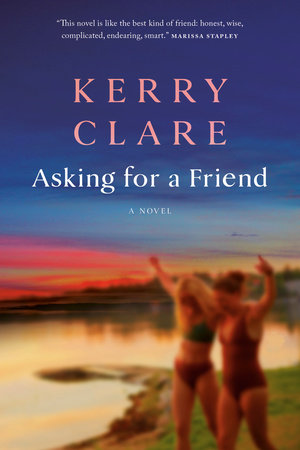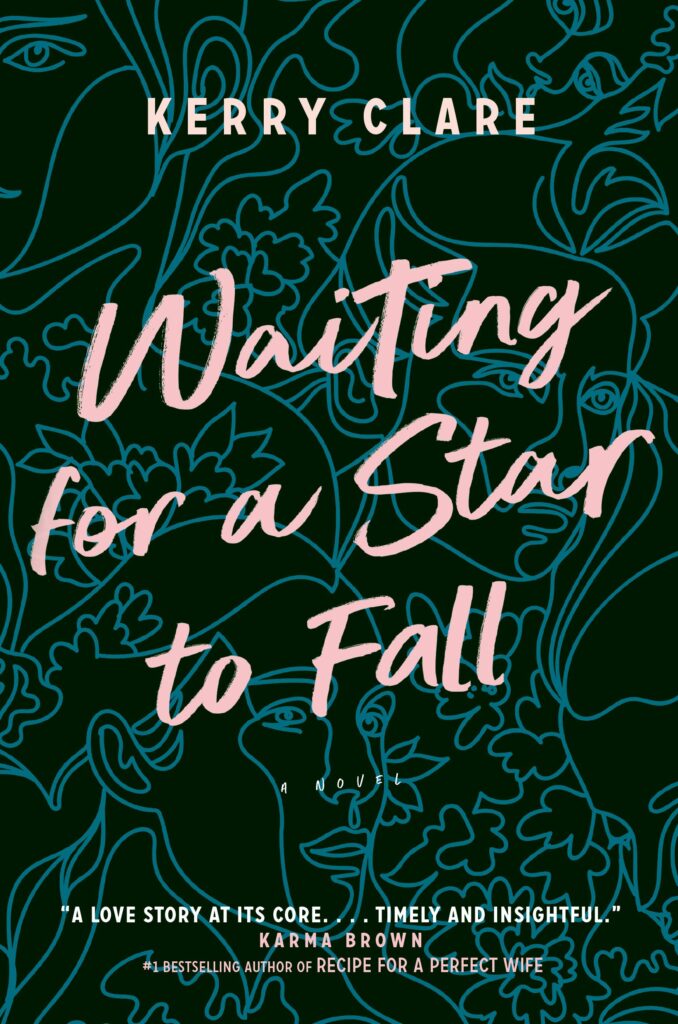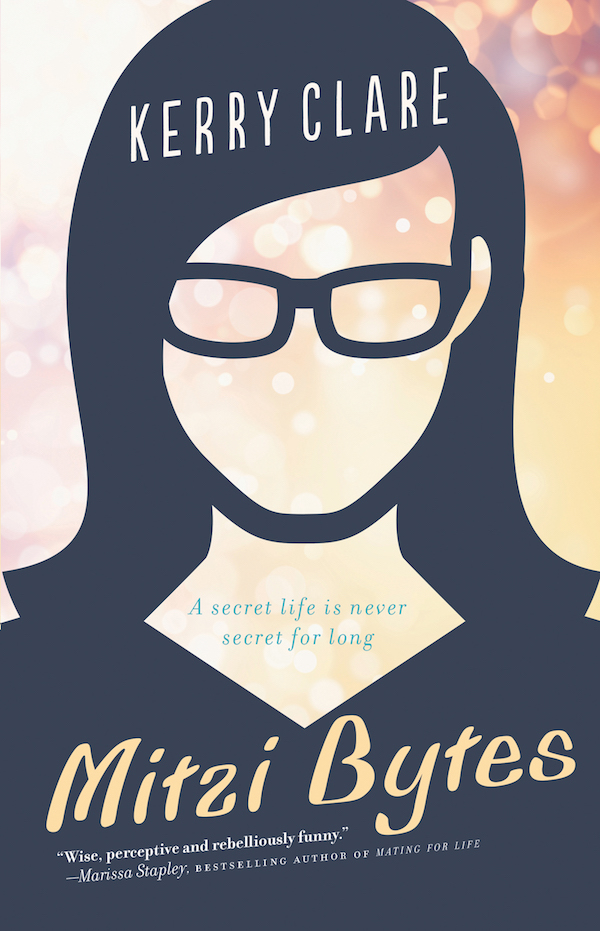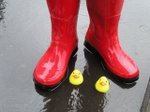April 5, 2018
Love and rope and goddamn determination

“If there is wisdom, it’s nothing I know. It’s all just birds and storms and hauntings. We look behind and scoff, as if those ahead aren’t doing the same.” —Rachel Lebowitz, The Year Of No Summer
I’ve been thinking this week about conciliation, about reconciling disparate things. All week I’ve been reading Ausma Zahanat Khan’s latest Esa Khattak novel, A Dangerous Crossing, which takes place in communities of migrants and refugees in Lesvos, Greece, who are hoping to be in transit to elsewhere. The thing about the book is how Khan shows how civil war has undermined notions of community. A point I’d never considered—how Syrians arriving in Canada don’t necessarily want to live among other Syrians, because after a Civil War there’s no longer an assumption that these people are your neighbours. The notion of a camp in Turkey for refugees who are dissidents from Assad’s regime, and who need to be protected from other Syrians who were brutalized and traumatized by these very forces. And then in the Greek camps, Greek Neo-Nazis on the fringes—there’s a terrifying scene of a group torching one of the camps. All the other countries being stingy about helping people in need, and amongst those people in need will inevitably be some who are corrupt and criminal—particularly since these are qualities that would help one survive in a war zone. And there will be rotten people in every population—including amongst the NGO and aid workers, those there to help but who instead are preying and abusive. How far go the waves of people’s capacity to be broken and awful?
I’ve also been listening to the CBC Podcast Finding Cleo, by Connie Walker, this week, another story of violence and trauma, improbable connections, and the ways in which abuses are replicated over and over. I’ve got three episodes left, but have been riveted by the story telling, by the personal stories, but also how the personal stories stand for what happened to thousands of Indigenous children across Canada for generations (and keeps happening today). A failure of systems, just like in Khan’s novel, and a failure of humanity. All these broken parts—how do we make something out oflf the pieces? Conciliate. Not to make a story, as Connie Walker has done so brilliantly, but instead to create something tangible that offers more than a promise that the story we tell in the future could be a different one.
I became unnerved on Tuesday evening after commenting on a Facebook thread (I know: why?) about my recent essay on family and abortion. This reminds me of a comment I’d heard years ago with Gloria Steinem in conversation with Jian Ghomeshi (I know, right?) about how when she first woke up to the message of the women’s movement, she thought creating change would be as simple as just explaining things so people would understand. Which was my intention with the essay, really. I will lay it all out and people will get it. Or if they don’t get it, they will still comprehend that there are things beyond their understanding—what a thing. But no.
I hope that some readers did come away from the piece with a different understanding of abortion than they had before, but these weren’t the ones posting on Facebook. I decided to leave polite comments anyway, thinking that even some dim awareness that the person who wrote that piece was a human being could represent progress. A tiny light bulb. I said, “Thank you for reading. I hope you might have learned something from considering my point of view.” But no, again.
“I have learned nothing,” one person responded. “I’ve just had it confirmed that we live in an evil world where people try to justify murdering children.” And sigh. Because what do I do with that? Furthermore, I know that many people who hold these beliefs do so because of deeply entrenched personal experiences—parenting a disabled child, experiencing miscarriage. These people’s convictions are so fundamental to who they are—I understand that. But what do we do with that? How do I, as a person without religion, reason with someone who tells me that one day I will have to atone to God for what I’ve done? And what does that person, for whom faith is everything, do with the fact that my own beliefs undermine the foundation of their moral universe? I could see how that would rankle. How do we put these pieces together? (Although the other person would posit that we don’t, that it’s the next world, the world I don’t believe in, in which all the pieces will finally fit.)
Can you see how my sleep on Tuesday night was restless and uneasy? And then I woke up on Wednesday morning and the weather was calling for high winds, and we were to beware of falling trees and flying objects. Which seemed, as my friend Nathalie put it, like perfect pathetic fallacy. I’d been wary of such things all week, metaphorically speaking, at least. And how exactly is one supposed to take care? Even wearing a helmet won’t suffice, and also wearing a helmet would be totally weird.
I was still thinking of my exchanges with the pro-lifers, the one who could not comprehend what I meant when I said that my daughter had really only existed when she was a five week old fetus because I was visualizing her as a baby, the one I desperately wanted and already so desperately loved. Because a five week old fetus is almost literally nothing, is what I meant, physically speaking. Pregnancy at five weeks is overwhelmingly perilous, but even still, I bought my daughter her first book when I was five weeks pregnant and read it to her before she had ears. But no. The woman on the Facebook thread didn’t get it. I’m not going to go back and recall what she said, but it was something along the lines of how horrifying it was that I’d be so narcissistic as to think that a person’s existence was determined by my perception alone. Which was ironic, because this person had no qualms about thinking that a person’s existence could be determined by her perception alone. Which was kind of my point all along, the way that one person’s embryo is another person’s baby. But this person was not in the mood for duality; she didn’t understand at all.
I was still thinking about this exchange when I read my All Lit Up Poetry Cure for the day (I’ve signed up to receive a poem a day in my inbox from All Lit Up Canada for National Poetry Month). The poem was “Five Weeks” by Rob Taylor (and aren’t they doing an uncanny job of very specifically curing our existential ailments; who planned that?):
Anonymous. A lima bean, they say.
No eyes or brain beneath
the flesh and blood and membrane
of my wife. But O my burning baby
anchors love within me. One day
you’ll wonder if any of this matters,
if you and it share a common bond,
if Love’s a word we pin to things
thin-skinned enough to pierce…
And here is where I thought perhaps there were answers. That I could send this poem to the woman on Facebook, and say, “This! This exactly.” Though I feel as though she’d appreciate the poem just as much as I’d appreciate her advice about what to tell God when I finally get to heaven.
While my own heart was mollified with the “Five Weeks” poem, it was still very windy, and I didn’t know how to watch out for falling trees and flying objects, let alone to make sense of the tragedy of Syrian refugees and cultural genocide. But then another poem arrived via one who knows well that poems are an everyday necessity—Vicki Ziegler. The poem was “Problems with Hurricanes,” by Victor Hernández Cruz:
A campesino looked at the air
And told me:
With hurricanes it’s not the wind
or the noise or the water.
I’ll tell you he said:
it’s the mangoes, avocados
Green plantains and bananas
flying into town like projectiles.How would your family
feel if they had to tell
The generations that you
got killed by a flying
Banana…
Which is just it precisely, reconciling the miracle and and amazingness of life itself with the absurdity of flying bananas. Later, “If you are going out/ beware of mangoes.” Always, I am aware of mangos. Of the strangeness, the sweetness, the awful violence, the golden flesh, the miracle of life, the inexplicability of everything.
“You think sometimes that things are holding still, or that just one thing is happening. That the volcano is erupting. That the Thames is freezing. That these men are fishing. That this couple here is drinking coffee, and all that is happening is the coffee in the cups, but all this time, the earth is changing, the babies and men and women are blowing off the cliff, or being held on by love and rope and goddamn determination.” —Rachel Lebowitz, The Year Of No Summer
April 3, 2018
“Enlarge and Complicate”
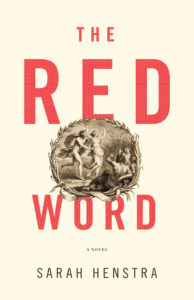 I’ve been reading so much lately—book after book, and while my backlist TBR shelf is suffering from neglect (I have a Penelope Mortimer book waiting, for heaven’s sake…) the wonders of Spring 2018 Canadian books are overwhelmingly good. I’m averaging about three books a week, and it’s still not enough for me to read everything I want to read, which is why I cannot be entirely despondent about the state of “CanLit” even as its politics give us very good reason to wonder what the point is. But the point, of course, is the books, and the books are excellent, and I’m also grateful that so many of these excellent books are written by people of colour (even if I think it’s a bit of a dry season for books by Indigenous writers, Terese Marie Mailhot’s amazing memoir Heart Berries—which I read last week—the only one that’s really on my radar…)
I’ve been reading so much lately—book after book, and while my backlist TBR shelf is suffering from neglect (I have a Penelope Mortimer book waiting, for heaven’s sake…) the wonders of Spring 2018 Canadian books are overwhelmingly good. I’m averaging about three books a week, and it’s still not enough for me to read everything I want to read, which is why I cannot be entirely despondent about the state of “CanLit” even as its politics give us very good reason to wonder what the point is. But the point, of course, is the books, and the books are excellent, and I’m also grateful that so many of these excellent books are written by people of colour (even if I think it’s a bit of a dry season for books by Indigenous writers, Terese Marie Mailhot’s amazing memoir Heart Berries—which I read last week—the only one that’s really on my radar…)
Anyway one book that stands out even though I read it in a whirlwind in early February (to see if it would be a good addition to the 49thShelf.com “#MeToo Reading List” I made; and hey, it was!) was The Red Word, by Sarah Henstra. It was a mindfuck of a book, such hard work, but also impossible to put down, incredibly compelling, a novel about campus culture, sexual violence, culpability, and the meaning of justice. I had the opportunity to ask Sarah some questions about her book over at 49th Shelf, and her answers were fantastic:
49th Shelf: The Red Word is hard work, in the very best way. It complicates binaries, messes with our notions of right and wrong, justice and injustice. Why was it important for you that this book not be a polemic? And was it difficult to make that happen?
Sarah Henstra: The Red Word tackles complicated subject matter, so I felt it warranted a complicated treatment. My decision to have the Raghurst women stage their attack on the fraternity the way they do arose from two separate impulses I felt as a writer, one having to do with what story I was telling and the other with how to tell the story. In the 1990s on college campuses (as elsewhere), the dice were so loaded against the survivors of sexual violence that justice seemed an impossible prospect. The young women in the novel are so frustrated with inequality, so sick of recording and reacting to the misdeeds of the frat boys without seeing any real changes, that they believe this is the only way forward, and they’re convinced—for a while, at least—that the ends will justify the means.
In terms of the story’s structure, I sought a scenario that would leave open the maximum number of possible resolutions in order to allow readers to remain curious and to consider a wide variety of perspectives and points of view. After all, it’s the unexpected consequences of the plot—those surprise moments when events blow up way past the characters’ intentions—that keep us reading.
I’ve always liked Susan Sontag’s assertion (in her 2004 lecture on South African Novel laureate Nadine Gordimer) that good novelists are “moral agents” precisely because the stories they tell don’t moralize but instead “enlarge and complicate—and, therefore, improve—our sympathies. They educate our capacity for moral judgment.” It definitely took this book longer to find a publisher because of its lack of a “redemptive” or “hopeful” resolution, though. “What is the takeaway here for feminism?” one editor asked me. Luckily, the editors who strongly connected with it (Amy Hundley at Grove, Susan Renouf at ECW) loved it precisely for its refusal to come down cleanly on one side of the conflict.
March 29, 2018
The Triumphant Tale of the House Sparrow, by Jan Thornhill

My husband got a new camera, and has been snapping photos all over town, including one shot of a ubiquity of sparrows in a tree, hopping from branch to branch and singing their song. He’d taken the photo after we all encountered the sparrows on our way to the library, pausing to watch them sparrowing. The sparrows were fascinating, and later as we looked at the photo we started talking about sparrows, how they were an invasive species, and I’d read once that that campaigns had used their domesticity (‘house’ sparrow) to have them further reviled—so it’s a gender issue, naturally. And then I realized that here was the segue I’d been waiting for.
“We have a book about sparrows, you know,” I said. A book that is absolutely gorgeous, Jan Thornhill’s The Triumphant Tale of the House Sparrow, which follows up on her award-winning The Tragic Tale of the Great Auk. I’d been intrigued by the sparrow book, but wasn’t sure what to do with it—it’s too long for bedtime reading, but looks like a picture book, so my biology-obsessed reader might not be inclined to pick it up on her own. So this was a perfect opportunity, and I started reading it out loud over dinner, and all of us were absolutely riveted.

Honestly, I’m not going to tell you everything, because I don’t want to deprive you of the experience we had again and again in this book, of beginning a new paragraph only to have our minds blown. We learned how sparrow species date back to prehistoric times and how populations of sparrows grew and changed their habits when humans discovered agriculture and started harvested the sparrow’s favourite food, which was grain. And now humans and sparrows have been living side-by-side ever since.
Sparrow populations spread as human populations did, house sparrows displaying their signature adaptability. But, Thornhill writes, “We humans have never been very good at sharing the food we grow with other animals—unless those animals are pets or livestock. The ones that eat our crops, we consider pests…and we always have.”
The remains of sparrows have been found in the stomachs of mummified falcons from ancient Egypt, and ancient Egyptians used a hieroglyph of a house sparrow to describe something as bad or evil. House sparrows would stow away on ships carrying the Roman legion. They grew so numerous that “sparrow catcher” became a legitimate occupation and sparrow bounties were demanded—although their meat was spare. “In fact, one old recipe for a simple sparrow pie calls for the meat from at least five dozen birds!”
But the house sparrow is not just detested. Thornhill underlining our own experience with the following paragraph: “[The house sparrow] can be fun to watch, particularly since it will go about its business—eating, preening, dust bathing, feeding its young—much closer to humans than other wild birds.” (We have spent hours over the years stopped at a house around the corner with a feeder in front watching the sparrows do what sparrows do. It never ever gets old…)
Sparrows were brought to North America and soon spread across the country, even hitching rides on boxcars with livestock and sharing their dinner. There were sparrow crackdowns even here eventually, though sparrow populations would soonafter decline for a different reason relating to the advent of automobiles, which was our favourite fact of the book (and such a neat lesson in unexpected consequences…). In 1958, Chairman Mao declared war on the Eurasian Tree Sparrow, which he saw as depriving food from Chinese people…and the decimated sparrow population that resulted would lead to a plague of insects, crop devastation, and a famine in which thirty million people starved to death.
The history of the house sparrow would turn out to be the history of everything, but the future of the house sparrow is also important. In some regions, sparrow populations having been declining for reasons scientists don’t understand, and while Thornhill is not an alarmist, she speculates that this reason might be important, and that the status of any species so connected with our own probably matters a lot. Because everything is actually connected, which is the very point of this wonderful, fascinating book.
March 29, 2018
The Apocalypse of Morgan Turner, by Jennifer Quist
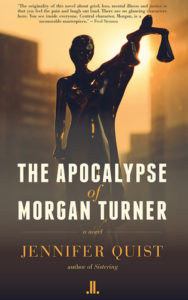 I listened to a wonderful segment on CBC’s The Current this morning about the necessity of changing our relationship with death, of re-familiarizing death as a concept and inventing (or rediscovering) rituals for it to be woven into the fabric of our lives. This same directive has also been the force behind Jennifer Quist’s first two novels, both of which were odd and oddly compelling, books that particularly preoccupied with death and the macabre. I read both of them and found them well-written and remarkable, but never quite knew what to make of them as a reader, let alone a reviewer. However Quist’s third novel, The Apocalypse of Morgan Turner, is the one I finally feel as though I’ve got a handle on—and I’m grateful to her publisher, Linda Leith Publishing, for their investment in voices who are a little outside the ordinary, in writers who are daring to do something different.
I listened to a wonderful segment on CBC’s The Current this morning about the necessity of changing our relationship with death, of re-familiarizing death as a concept and inventing (or rediscovering) rituals for it to be woven into the fabric of our lives. This same directive has also been the force behind Jennifer Quist’s first two novels, both of which were odd and oddly compelling, books that particularly preoccupied with death and the macabre. I read both of them and found them well-written and remarkable, but never quite knew what to make of them as a reader, let alone a reviewer. However Quist’s third novel, The Apocalypse of Morgan Turner, is the one I finally feel as though I’ve got a handle on—and I’m grateful to her publisher, Linda Leith Publishing, for their investment in voices who are a little outside the ordinary, in writers who are daring to do something different.
And of course, The Apocalypse of Morgan Turner is also about death, but the lens is wider here, and so too is the story’s resonance. Whereas Quist’s previous novels were concentrated on individual families and their esoteric habits and rituals, The Apocalypse… involves two very families, the interactions and intersections between those two families, and also with other individuals with a wide range of cultural and socioeconomic backgrounds. At the centre of the novel is Morgan Turner herself, three years after the brutal murder of her sister Tricia. Three years after so that some of the shock and trauma of such a violent crime has faded away, and the narrative can consume itself with ideas beyond conventional grief and loss. Important too: Morgan and Tricia were not especially close, and her sister’s death has not left a gaping hole in Morgan’s life. Also, Morgan Turner is not a person who demands a lot of life or the world anyway—she’s content enough taking the bus every day to her job washing dishes in a fast food restaurant. So that she might not rail at the universe for all its injustices the way another character would who’d see herself at that universe’s centre.
Which is not to say that Morgan isn’t questioning: how does a person begin to move on after such a tragedy? The question particularly relevant as the trial for Tricia’s accused killer is coming up, and he’s planning to plead that he’s not criminally responsible for what happened to him. Which, naturally, is upsetting for the entire Turner family, although they all handle it in different ways. Morgan’s parents, Marc and Sheila, are divorced, and Marc has made himself a (rather self-serving) media sensation for his forgiveness of his daughter’s killer—and Quist’s black humour is apparent here with her poignant portrayal of the pretty ridiculous Marc, as compared to his ex-wife:
Sheila’s anger is always raw and steaming, irresolvable. Her story is tenacity‚ chasing Finnemore toward a crushing, punishing destiny she has already publicly denounced as insufficient. When she and Marc divided up their archetypes, he chose the wrong side. His story of cooling and moving on—a loud, public claim of letting go. Soon, he will have to stop talking about it, stop posing for it, stop pleading for it, and do it.
Morgan’s feelings manifest in stranger ways—she becomes preoccupied with horror films, she ones she remembers from during the brief time her sister had been a film studies major before she dropped out of school. She also becomes obsessed with the abattoir where her brother works, and ends up getting job in the factory kitchen, where she connects with Chinese colleagues over an obsession with Korean soap operas. Meanwhile, she’s attending meetings with the crown attorney who’ll be prosecuting the case, not her lawyer, no. The family doesn’t have a lawyer, of course, or a real place in this process (which is part of the reason that Morgan doesn’t know what to do). The lawyer prosecuting the case has a family of his own, a sister Morgan encounters one day while she’s clearing tables in the restaurant where she works. This is Gillian, “a Mormon do-gooder,” who pops in and out of Morgan’s life after that. And Gillian’s other brother, Paul, who is schizophrenic and who is grappling with his own problems with the legal system. And together, all of these characters provide Morgan with the spiritual scaffolding to process what happened to her sister and her family, and to begin to move on with her life.
I loved this book. Quist’s narratives are always rich and compelling, and this latest novel is no exception. It’s sad and brutal, but also sweet and funny, and all its characters are so real. It also becomes such a page turner as the story progresses, the trial nearing its end, Morgan’s desperate attempt to be there for the verdict—there is so much tension. We’re also been privy to the lawyer working into the early hours of morning on the case, and how high are the stakes, and what does it all mean? And where do we find that meaning, which is the novel’s central question, and Morgan Turner’s revelation. Revelation being another word for “apocalypse,” which is only just about destruction and devastation as we understand it in the pop-cultural sense, but instead what is revealed by devastation, a divine truth. Or truths, maybe, which is what happens here with the generosity of the people Morgan meets, with what they show her, unwittingly, or otherwise, about this awful, amazing, brutal, beautiful world.
March 27, 2018
Catch My Drift, by Genevieve Scott
 I was always going to have an affinity for Genevieve Scott’s debut novel, Catch My Drift. Its protagonist, Cara, is nearly my exact contemporary, and I also have a strong fascination with the 1970s’ Toronto that brought my parents together and delivered us all into the world I remember from my childhood. I’m also kind of crazy about Swim-Lit, although Catch My Drift is only really pool-centric in the first chapter, which is when Cara’s mother Lorna is a on the cusp of trying out for the Varsity swim team at the University of Toronto. It’s 1975, and swimming is her entire identity, her whole life. Which has already been rocked by the end of a romance and a car accident in which her knees were injured, undermining her swimming potential. It’s summer and she’s training at the pool where her roommate is a lifeguard, sneaking in for laps just before closing. But when it comes time to prove herself, Lorna flinches, setting in motion the rest of her life, for better or for worse.
I was always going to have an affinity for Genevieve Scott’s debut novel, Catch My Drift. Its protagonist, Cara, is nearly my exact contemporary, and I also have a strong fascination with the 1970s’ Toronto that brought my parents together and delivered us all into the world I remember from my childhood. I’m also kind of crazy about Swim-Lit, although Catch My Drift is only really pool-centric in the first chapter, which is when Cara’s mother Lorna is a on the cusp of trying out for the Varsity swim team at the University of Toronto. It’s 1975, and swimming is her entire identity, her whole life. Which has already been rocked by the end of a romance and a car accident in which her knees were injured, undermining her swimming potential. It’s summer and she’s training at the pool where her roommate is a lifeguard, sneaking in for laps just before closing. But when it comes time to prove herself, Lorna flinches, setting in motion the rest of her life, for better or for worse.
We meet Cara in the next chapter, 1987, nine-years-old, and see Lorna now, no longer a woman on the cusp of her life, but instead a mom. A mom who’s dealing with an unreliable partner, the domestic demands of parenthood, and the consequences of a life she made that hasn’t turned out like she might have imagined. But all this is on the periphery—the narrative is filtered through the perspective of Cara, for whom her mother doesn’t really exist as a character in her own right yet. And so the story goes, moving back and forth from mother to daughter as the years go on, as Cara develops into her own person and Lorna reconciles with her own choices, a life with a lot she is proud of. Although at this point, we’re still seeing her through the disdainful eyes of her teenage daughter, who is grappling with her own questions about the kind of woman she wants to be, so it’s complicated. But it is the subtle softening of Cara’s understanding of her mother, her own emerging sympathy for her that is my favourite part of the novel, and culminates in an ending I feared would be heartbreaking but ended up being perfect and beautiful.
Not everything is subtle in Catch My Drift. Some secondary characters border on caricature. This is a novel composed of pieces and the shape of it all is a little unwieldy. In some places it reads like a first novel…but the more I read, the more assured I was by the project, and the more the story appealed to me beyond simple nostalgia. Partly because it becomes clear that nostalgia is a point the novel hangs on—what do we remember and why? What version of reality are those memories made of? How did we get from here to there? What are the consequences of our actions, both in our own destinies and in the lives of others? Because the answers are wondrous and far-reaching, even in the most ordinary lives.
March 26, 2018
A One-Handed Novel, by Kim Clark
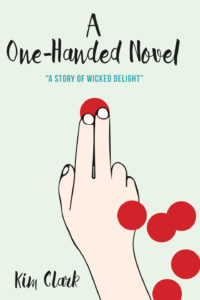 It’s a quandary, certainly, and not one I’ve ever encountered in fiction before. Melanie Farrell has already done most of the things you read about in novels—she’s come of age, gotten married, been divorced, confronted a life-changing diagnosis (Multiple Sclerosis) etc. etc., but now in Kim Clark’s A One-Handed Novel, her doctor delivers her some devastating news. Her disease is progressing (not news) and a neurological test has revealed she has just six orgasms left. Six! And she’s already spent once since the test, she realizes—what to do? And so begins her journey to use those remaining orgasms to their best and fullest potential, to make each one count. But then best intentions have always been Melanie’s downfall—witness the items on her Twelve Days of Christmas list, which are most consistently “liquor” and “guilt”. With hilarity and so much heart, Clark takes her reader on Melanie’s journey to make the most of her remaining orgasms. A comic novel about MS—who would have thought it? But it’s also about sex, about coming to terms with one’s bodily limitations, and about friendship, money, hope, and community. It’s not so narratively taut—a third of the way through the remaining orgasms conceit is put aside while Melanie travels to Costa Rica for the expensive and controversial “liberation therapy” which fails to deliver the results she is looking for. Clark also relies too much on humour to carry the story, poignant moments rushed by to arrive at a wisecrack. The end of the novel also crosses the line beyond ridiculous and I feel like some meaning gets lost in the absurdity…and yet. And yet, how can you criticize someone’s narrative trajectory in their comic novel about MS? I feel like the humour and absurdity is a form of resistance, against the cliches and inspiration readers are often seeking in memoirs of disability and illness. The narrative’s all-over-the-placecess too is appropriate for a story of a progressive disease, with the arrival of symptoms where they’re least expected, some improvement, a step forward and two steps back, and then the possibilities that arrive with wild hope, that necessary wild hope—maybe indeed liberation therapy in Costa Rica will produce a miraculous cure? A progressive illness is not a straight line, but neither is any life experience, and so to expect a story to conform to such neatness is an awful lot to ask. I really enjoyed this book, its humour, its wildness, and its point of view—and my appreciation for it was underlined by an understanding of Clark’s background as a playwright. Because while this not the most perfectly shaped novel I have ever read, Clark has got her character’s voice (first person) so exactly perfect. It’s a voice for a monologue, a voice that begs to be performed, funny, generous and wise, and it’s a voice that echoes in the reader’s mind long after the novel is finished.
It’s a quandary, certainly, and not one I’ve ever encountered in fiction before. Melanie Farrell has already done most of the things you read about in novels—she’s come of age, gotten married, been divorced, confronted a life-changing diagnosis (Multiple Sclerosis) etc. etc., but now in Kim Clark’s A One-Handed Novel, her doctor delivers her some devastating news. Her disease is progressing (not news) and a neurological test has revealed she has just six orgasms left. Six! And she’s already spent once since the test, she realizes—what to do? And so begins her journey to use those remaining orgasms to their best and fullest potential, to make each one count. But then best intentions have always been Melanie’s downfall—witness the items on her Twelve Days of Christmas list, which are most consistently “liquor” and “guilt”. With hilarity and so much heart, Clark takes her reader on Melanie’s journey to make the most of her remaining orgasms. A comic novel about MS—who would have thought it? But it’s also about sex, about coming to terms with one’s bodily limitations, and about friendship, money, hope, and community. It’s not so narratively taut—a third of the way through the remaining orgasms conceit is put aside while Melanie travels to Costa Rica for the expensive and controversial “liberation therapy” which fails to deliver the results she is looking for. Clark also relies too much on humour to carry the story, poignant moments rushed by to arrive at a wisecrack. The end of the novel also crosses the line beyond ridiculous and I feel like some meaning gets lost in the absurdity…and yet. And yet, how can you criticize someone’s narrative trajectory in their comic novel about MS? I feel like the humour and absurdity is a form of resistance, against the cliches and inspiration readers are often seeking in memoirs of disability and illness. The narrative’s all-over-the-placecess too is appropriate for a story of a progressive disease, with the arrival of symptoms where they’re least expected, some improvement, a step forward and two steps back, and then the possibilities that arrive with wild hope, that necessary wild hope—maybe indeed liberation therapy in Costa Rica will produce a miraculous cure? A progressive illness is not a straight line, but neither is any life experience, and so to expect a story to conform to such neatness is an awful lot to ask. I really enjoyed this book, its humour, its wildness, and its point of view—and my appreciation for it was underlined by an understanding of Clark’s background as a playwright. Because while this not the most perfectly shaped novel I have ever read, Clark has got her character’s voice (first person) so exactly perfect. It’s a voice for a monologue, a voice that begs to be performed, funny, generous and wise, and it’s a voice that echoes in the reader’s mind long after the novel is finished.
March 22, 2018
“But you see, Meg, just because we don’t understand doesn’t mean the explanation doesn’t exist.”

I wrote about abortion again. Boring, I know, but every time I write about abortion, it seems to more and more politically imperative to do so. And this piece is one of the best essays I’ve ever written, I think. I’m really proud of it and feel good having those words, this story, out in the world. It’s such a common story, but for so many reasons, it’s not one we read about or hear about very often. Though I’m writing it not just for myself and so many women like me whose uncomplicated, ordinary, straightforward stories of abortion are that it was a good thing, a blessing, and simultaneously not a big deal but also such an important part of our lives. I’m writing it also with the hope of reaching someone who sees abortion as killing a baby, and cannot fathom how it could ever be ordinary, let alone a blessing. Not even to change their mind, but to have them entertain the notion of considering a different point of view. “I understand where you’re coming from,” I want to tell them, because I do, “but for a moment just consider my story.”
Which makes me think of a idea that keeps recurring in Madeleine L’Engle’s A Wrinkle in Time, which I’m reading aloud to my family at the moment. Uttered first in a line by Meg Murry’s mother, who tells her, “But you see, Meg, just because we don’t understand doesn’t mean the explanation doesn’t exist.” Just because someone doesn’t understand my story doesn’t mean my story isn’t true. My story is, no matter how much that complicates your worldview. I’ve written before about being grateful for my abortion, for what it’s taught me about in-betweenness and grey areas, and about the value of listening to people and believing them when they tell you about their experiences. Even if you can’t identify, even if you can’t understand. Because it’s possible that the limits of your understanding are also the limits of your point of view, and I want my ideas to be able to travel further than that. And I hope that other people might see the benefits of such open-mindedness as well.
March 20, 2018
New books by Elisabeth de Mariaffi and Nathan Ripley
Hysteria, by Elisabeth de Mariaffi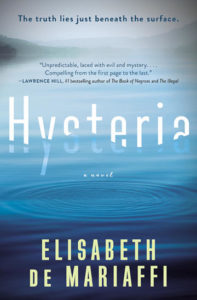
The week I was reading Hysteria, I was a bit all over the place, and in the beginning was having some trouble following the novel. “Is it you or me?” I wondered, which was kind of fitting, because the protagonist is wondering the same thing about everybody around her. The novel wasn’t what I’d been expecting either—from the jacket copy, I’d been picturing Gone Girl, domestic suspense, and girls on trains. But then I began reading and found myself in the land of Betty Draper—although not before a prologue with fairy tale elements, a girl lost in the woods and even in the land of Grimms, not far from Dresden near the end of World War Two. But de Mariaffi’s Betty and the girl in the woods turn out to be the same person, just a decade apart. Heike, rescued from a Swiss convent by her American doctor husband—she’d been for a time his patient—who has delivered her to America, and now to a lake house in New York State near the mental hospital where he is working and where Heike will spend the summer caring for their four-year-old son. All of which isn’t to say that I wasn’t enjoying the book—I adored de Mariaffi’s previous novel, The Devil You Know—but instead that I found it disorienting, and I soon realized that I was supposed to. Because Heike, like I felt as a reader, is also out of place and unable to trust her own senses—she’s fragile from her wartime trauma and her husband keeps giving her pills that make her dozy. So that when she starts seeing ghostly images of a young girl, it generally seems in keeping with the spirit of things. And then her son disappears, and Heike’s husband won’t tell her where he’s gone, and it’s around this point when Heike’s agency becomes apparent and she takes up with a television writer inspired by the creator of The Twilight Zone, and I was thinking about The Turn of the Screw and the mechanics of ghost stories. Hysteria was excellent, even before I found my feet, and now I want to go back and find my way through it again.
*
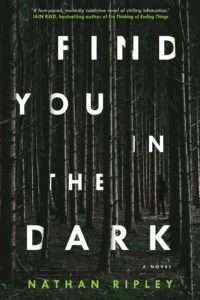 Find You in the Dark, by Nathan Ripley
Find You in the Dark, by Nathan Ripley
Once you’re reading enough books about murder, your standards for gruesomeness start to change, so that all of the sudden you’re on the radio saying, “Oh, yeah, it’s a book about a man obsessed with serial killers and digging up the long-lost remains of their unclaimed victims.” Like that isn’t weird at all, right? Which is the point of Find You in the Dark, by Ripley (a pseudonym for the award-winning Naben Ruthnum), the way that it’s easy to be swayed by the protagonist, Martin Reese, a retired tech millionaire whose hobby just happens to be unearthing remains. Plus, he’s married to the sister of a woman who disappeared twenty years ago, and begins to slip comments about nasty deeds committed in his youth. Is Martin—loving husband and father, albeit a bit weird—really such an ordinary guy? The reader begins to discern that his intentions aren’t as honourable as he’d have us suppose. And we aren’t the only ones who are suspicious, because someone else has found out what he’s up to and there’s a fresh body buried in a decades-old grave, and Martin Reese’s carefully constructed reality is seriously under threat. There’s also a kick-ass police detective who is smarter than he is, so Martin has to figure out something fast. But do we want him to? Is he a good guy or bad? That moral ambiguity is one of the most compelling parts of the novel, whose creepiest aspect turns out not to be the unearthed bodies, but instead the experience of being made to feel so sympathetic to such a messed up mind.
March 19, 2018
The next star.
“If our ability to see detail in a woman’s face is magnified by our visual habits, our ability to see complexity in a woman’s story is diminished by our reading habits. Centuries of experience in looking at the one through a magnifying glass has engendered a complementary practice of looking at the other through the wrong end of a telescope. Faced with a woman’s story, we’re overtaken with the swift taxonomic impulse an amateur astronomer feels on spotting Sirius—there it is! he says, and looks to the next star. It’s a pleasant activity because it organizes and confirms, but it produces the fantasy that a lazy reading—not even a reading but a looking—is adequate, sufficient, complete, correct.”
How incredible when an essay can articulate so much you’ve always understood, and yet at the same time teach you a boatload. I loved this; read “The Male Glance,” by Lili Loofbourow.
March 16, 2018
March Break Special: The Big Bed, by Bunmi Laditan
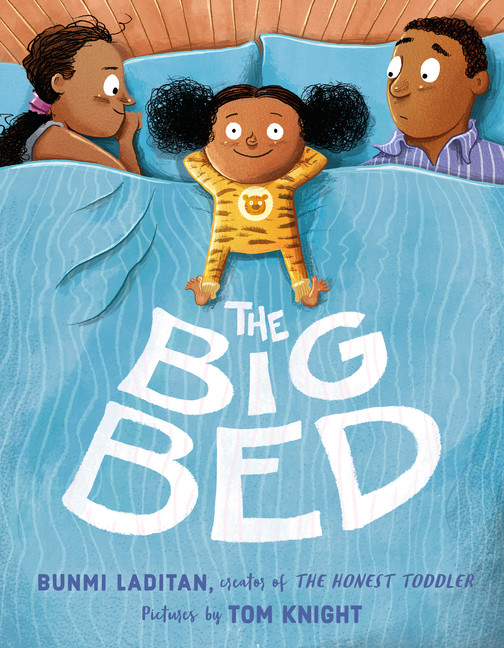
A weird thing is March Break just a week after a week-long vacation, which makes it seem like those few days of school were a blip and we’ve been on vacation forever. And I am the luckiest because I work from home and therefore March Break gets to be a real thing here (except I am also the unluckiest, because it means I have to cram my workday into a couple of hours every morning while my children watch television; come next week I’ll have catching up to do). We didn’t have elaborate plans for the week, but they’ve come together nicely, and we’ve been up to fun things and enjoying evenings without the rush of getting to various activities and also no making lunches. And so to celebrate this free-and-easy week of goodness, I’m making this week’s Picture Book Friday selection a book that my children absolutely adore, a real crowd-pleaser, a book my littlest calls “the pee-pee book,” which is The Big Bed, by Bunmi Laditan, illustrated by Tom Knight.
You probably already know Laditan as the writer behind the very funny Honest Toddler blog and book, and she brings the same approach and humour to her first picture book. It’s written in the voice of a young child who is very persuasive and attempting to explain to her father just why she deserves his spot in the big bed with Mommy. “When day turns to night, it’s normal for people to seek comfort. No one can deny that Mommy is full of cozies and smells like fresh bread. Who wouldn’t want to cuddle with her?” Making good points too: “Quick question: Am I mistaken, or don’t you already have a mommy? Perhaps Grandma is available to sing you to sleep three or four nights a week.” And yes, maybe the narrator does tend to leave the bed a little, um, damp in the morning—but she’s got good three reasons why this is actually a positive thing (even if they are a little yuck). She’s even got a plan, in the form of a camping cot. She’s even going to let her daddy pick out some special new sheets for his “awesome sleeping rectangle.”
It’s a story that resonates for all of us, mostly because there was an extra body or two in our bed for years and I do indeed remember the struggles. Though to those of you still in the midst of sleep struggles or bed woes, maybe hold off on this book for just a little while longer. You wouldn’t want your little bed sharer getting any more ideas….
